Analysis of Microwave Thermal Stress Fracture Characteristics and Size Effect of Sandstone under Microwave Heating
Abstract
1. Introduction
2. Samples, Equipment, and Test Methods
2.1. Rock Samples
2.2. Microwave Heating Test
2.3. Temperature Test
2.4. P-Wave Velocity Test
3. Test Results
3.1. Sample Quality
3.2. Sample Temperature
3.3. P-Wave Velocity of the Sample
3.4. Specimen Crack Propagation and Fracture Characteristics
3.4.1. Specimen Crack Propagation Characteristics
3.4.2. Specimen Fracture Characteristics
4. Analysis and Discussion
4.1. Effect of Energy on Sample Temperature
4.2. Effect of Energy on Damage Factor
4.3. Fracture Mechanism of Samples under Microwave Heating
5. Conclusions
- (1)
- microwave heating of rock samples of different sizes has different heating effects. Under the same heating conditions, the mass difference and temperature increase range of φ 50 × 100 mm and φ 50 × 50 mm samples are larger than that of φ 50 × 25 mm samples;
- (2)
- different size specimens have different crack-propagation modes. The main crack of φ 50 × 100 mm specimens usually starts from the middle of the height of the specimen; the main crack of φ 50 × 50 mm specimens usually starts from the middle or bottom-end surface of the specimen height; the main crack of the φ 50 × 25 mm specimen starts to crack from the vertical surface of the specimen. As the heating time increases, the crack length and width also increase;
- (3)
- different sizes of specimens have different fracture modes (Only sandstone with the same mineral composition). The φ 50 × 100 mm sample fractured from the middle of the sample into two sections, the φ 50 × 50 mm sample fractured from the top of the sample into two parts in an approximately vertical direction, and φ 50 × 25 mm specimens have fractured bumps on the local rock blocks at the top of the specimens;
- (4)
- the microwave energy absorbed by the sample is approximately linear with the temperature. The more microwave energy absorbed by the sample, the higher the temperature, the greater the sample mass difference, the greater the P-wave velocity change rate and damage factor, the more developed the crack network, and the shorter the fracture time.
Author Contributions
Funding
Conflicts of Interest
References
- Gao, F.; Tang, L.; Zhou, K.; Zhang, Y.; Ke, B. Mechanism Analysis of Liquid Carbon Dioxide Phase Transition for Fracturing Rock Masses. Energies 2018, 11, 2909. [Google Scholar] [CrossRef]
- Khan, N.; Abas, N.; Kalair, A. Pulsed and Continuous Wave (CW) Lasers in the Oil, Gas, Coal and Ignition Industries. Lasers Eng. 2015, 30, 137–157. [Google Scholar]
- Lu, G.M.; Feng, X.T.; Li, Y.H.; Zhang, X.W. The Microwave-Induced Fracturing of Hard Rock. Rock Mech. Rock Eng. 2019, 52, 3017–3032. [Google Scholar] [CrossRef]
- Lu, Y.Y.; Huang, F.; Liu, X.C.; Ao, X. On the failure pattern of sandstone impacted by high-velocity water jet. Int. J. Impact Eng. 2015, 76, 67–74. [Google Scholar] [CrossRef]
- Chen, T.T.; Dutrizac, J.E.; Haque, K.E.; Wyslouzil, W.; Kashyap, S. The Relative Transparency of Minerals to Microwave Radiation. Can. Metall. Q. 1984, 23, 349–351. [Google Scholar] [CrossRef]
- Hassani, F.; Nekoovaght, P.M.; Gharib, N. The influence of microwave irradiation on rocksfor microwave assisted underground excavation. J. Rock Mech. Geotech. Eng. 2016, 8, 1–15. [Google Scholar] [CrossRef]
- Hassani, F.; Radziszewski, P.; Ouellet, J.; Nokkent, M.; Nekoovaght, P. Microwave Assisted Drilling and Its Influence on Rock Breakage A Review. In Proceedings of the ISRM International Symposium—5th Asian Rock Mechanics Symposium, Tehran, Iran, 24–26 November 2008. [Google Scholar]
- Peinsitt, T.; Kuchar, F.; Hartlieb, P.; Moser, P.; Kargl, H.; Restner, U.; Sifferlinger, N.A. Microwave heating of dry and water saturated basalt, granite and sandstone. Int. J. Min. Miner. Eng. 2010, 2, 18–29. [Google Scholar] [CrossRef]
- Hu, G.Z.; Sun, C.; Huang, J.X.; Xu, G.; Zhu, J.Q. Evolution of Shale Microstructure under Microwave Irradiation Stimulation. Energy Fuels 2018, 32, 11467–11476. [Google Scholar] [CrossRef]
- Wang, H.C.; Rezaee, R.; Saeedi, A. Preliminary study of improving reservoir quality of tight gas sands in the near wellbore region by microwave heating. J. Nat. Gas Sci. Eng. 2016, 32, 395–406. [Google Scholar] [CrossRef]
- He, L.P.; Chen, Y.; Zeng, J.S.; Hu, Q.J.; Shao, D.D.; Zhang, H.B.; Lu, X.R. The thermal damaging process of diorite under microwave irradiation. Frat. Integrita Strut. 2019, 47, 65–73. [Google Scholar] [CrossRef]
- Lu, G.M.; Feng, X.T.; Li, Y.H.; Hassani, F.; Zhang, X.W. Experimental Investigation on the Effects of Microwave Treatment on Basalt Heating, Mechanical Strength, and Fragmentation. Rock Mech. Rock Eng. 2019, 52, 2535–2549. [Google Scholar] [CrossRef]
- Like, Q.; Jun, D. Analysis on the growth of different shapes of mineral microcracks in microwave field. Frat. Integrita Strut. 2016, 342–351. [Google Scholar] [CrossRef]
- Ali, A.Y.; Bradshaw, S.M. Quantifying damage around grain boundaries in microwave treated ores. Chem. Eng. Process. 2009, 48, 1566–1573. [Google Scholar] [CrossRef]
- Ali, A.Y.; Bradshaw, S.M. Bonded-particle modelling of microwave-induced damage in ore particles. Miner. Eng. 2010, 23, 780–790. [Google Scholar] [CrossRef]
- Jones, D.A.; Kingman, S.W.; Whittles, D.N.; Lowndes, I.S. Understanding microwave assisted breakage. Miner. Eng. 2005, 18, 659–669. [Google Scholar] [CrossRef]
- Jones, D.A.; Kingman, S.W.; Whittles, D.N.; Lowndes, I.S. The influence of microwave energy delivery method on strength reduction in ore samples. Chem. Eng. Process. 2007, 46, 291–299. [Google Scholar] [CrossRef]
- Hartlieb, P.; Leindl, M.; Kuchar, F.; Antretter, T.; Moser, P. Damage of basalt induced by microwave irradiation. Miner. Eng. 2012, 31, 82–89. [Google Scholar] [CrossRef]
- Toifl, M.; Hartlieb, P.; Meisels, R.; Antretter, T.; Kuchar, F. Numerical study of the influence of irradiation parameters on the microwave-induced stresses in granite. Miner. Eng. 2017, 103, 78–92. [Google Scholar] [CrossRef]
- Toifl, M.; Meisels, R.; Hartlieb, P.; Kuchar, F.; Antretter, T. 3D numerical study on microwave induced stresses in inhomogeneous hard rocks. Miner. Eng. 2016, 90, 29–42. [Google Scholar] [CrossRef]
- Li, J.L.; Kaunda, R.B.; Arora, S.; Hartlieb, P.; Nelson, P.P. Fully-coupled simulations of thermally-induced cracking in pegmatite due to microwave irradiation. J. Rock Mech. Geotech. Eng. 2019, 11, 242–250. [Google Scholar] [CrossRef]
- Satish, H. Exploring Microwave Assisted Rock Breakage for Possible Space Mining Application. Master Thesis, McGill University, Montreal, QC, Canada, 2005. [Google Scholar]
- Lu, G.M.; Li, Y.H.; Hassani, F.; Zhang, X.W. The influence of microwave irradiation on thermal properties of main rock-forming minerals. Appl. Therm. Eng. 2017, 112, 1523–1532. [Google Scholar] [CrossRef]
- Sun, Q.; Zhang, Z.; Xue, L.; Zhu, S. Physico-mechanical properties variation of rock with phase transformation under high temperature. Chin. J. Rock Mech. Eng. 2013, 32, 935–942. [Google Scholar]
- Zhao, H.; Yin, G.; Chen, L. Experimental study on effect of temperature on sandstone damage. Chin. J. Rock Mech. Eng. 2009, 28, 2784–2788. [Google Scholar]
- Jerby, E.; Shoshani, Y. Localized microwave-heating (LMH) of basalt—Lava, dusty-plasma, and ball-lightning ejection by a miniature volcano. Sci. Rep. 2019, 9, 1–15. [Google Scholar] [CrossRef]
- Jin, Z.-M.; Green, H.W.; Zhou, Y. Melt topology in partially molten mantle peridotite during ductile deformation. Nature 1994, 372, 164–167. [Google Scholar] [CrossRef]
- Zeng, J.S.; Hu, Q.; Chen, Y.; Shu, X.; Chen, S.; He, L.; Tang, H.; Lu, X. Experimental investigation on structural evolution of granite at high temperature induced by microwave irradiation. Mineral. Petrol. 2019, 113, 745–754. [Google Scholar] [CrossRef]
- Zhu, W.L.; Gaetani, G.A.; Fusseis, F.; Montesi, L.G.J.; De Carlo, F. Microtomography of Partially Molten Rocks: Three-Dimensional Melt Distribution in Mantle Peridotite. Science 2011, 332, 88–91. [Google Scholar] [CrossRef]
- Ming, L. Research on Rupture Mechanisms of Coal Measures Sandstone under High Temperature and Impact Load. Ph.D. Thesis, China University of Mining and Technology, Beijing, China, 2014. [Google Scholar]


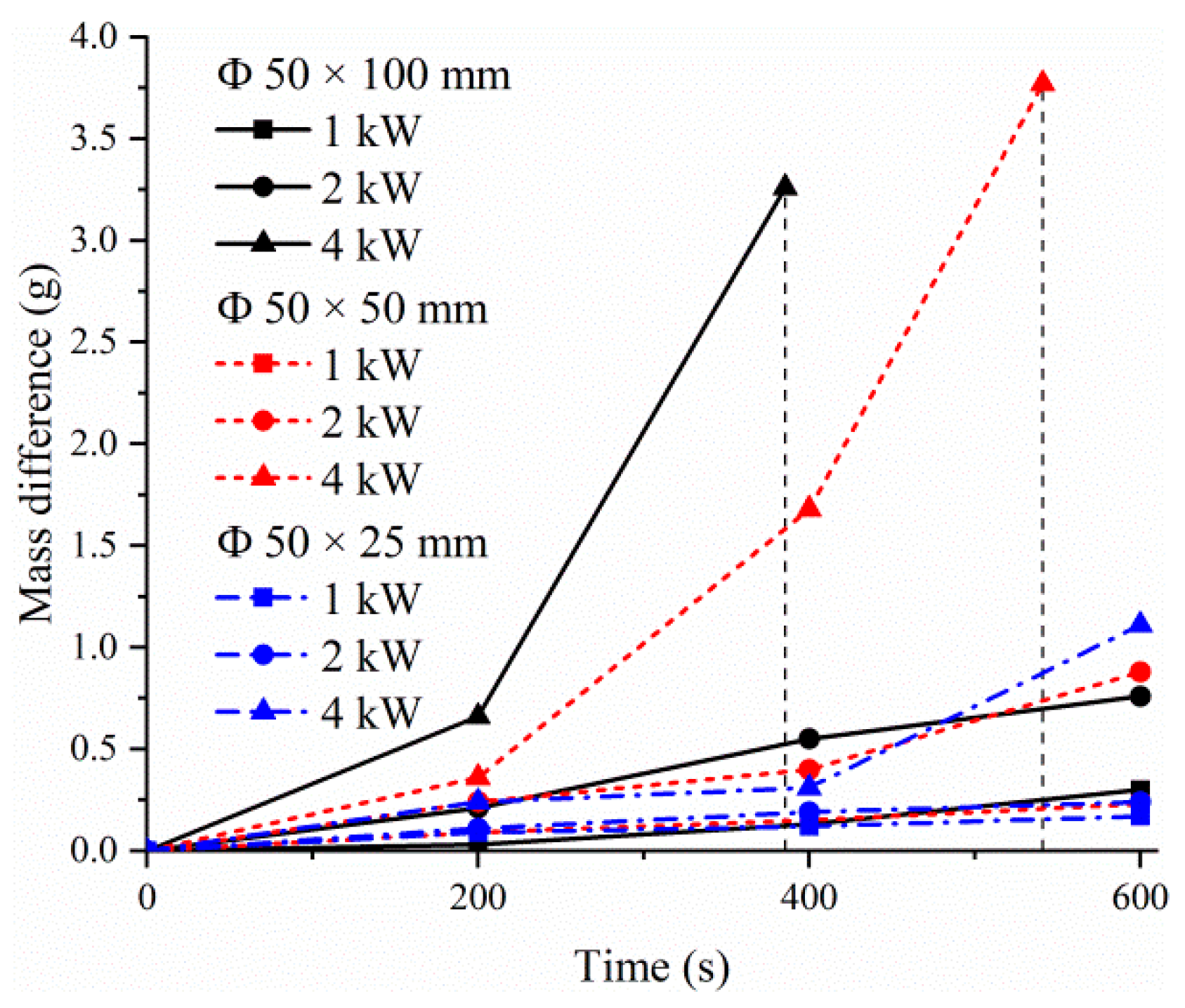
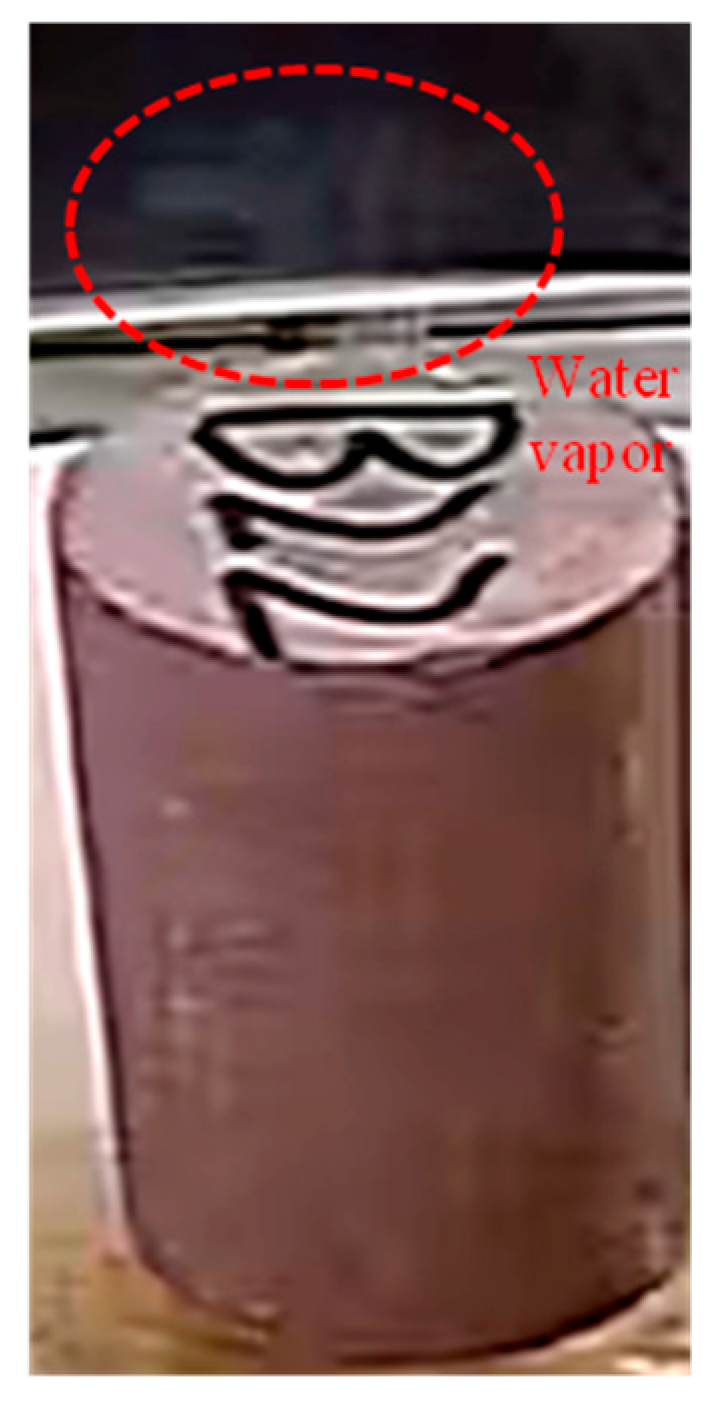

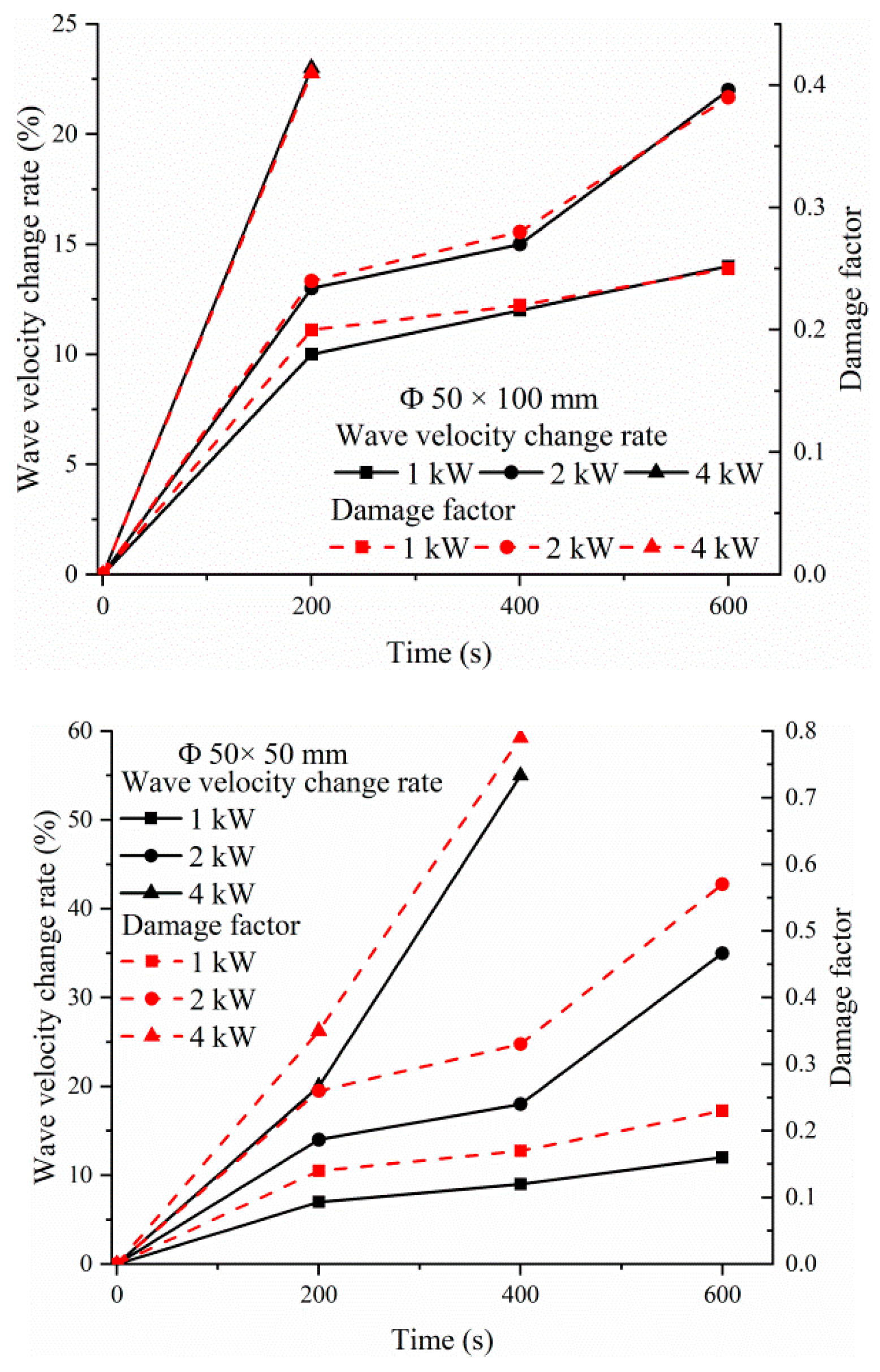
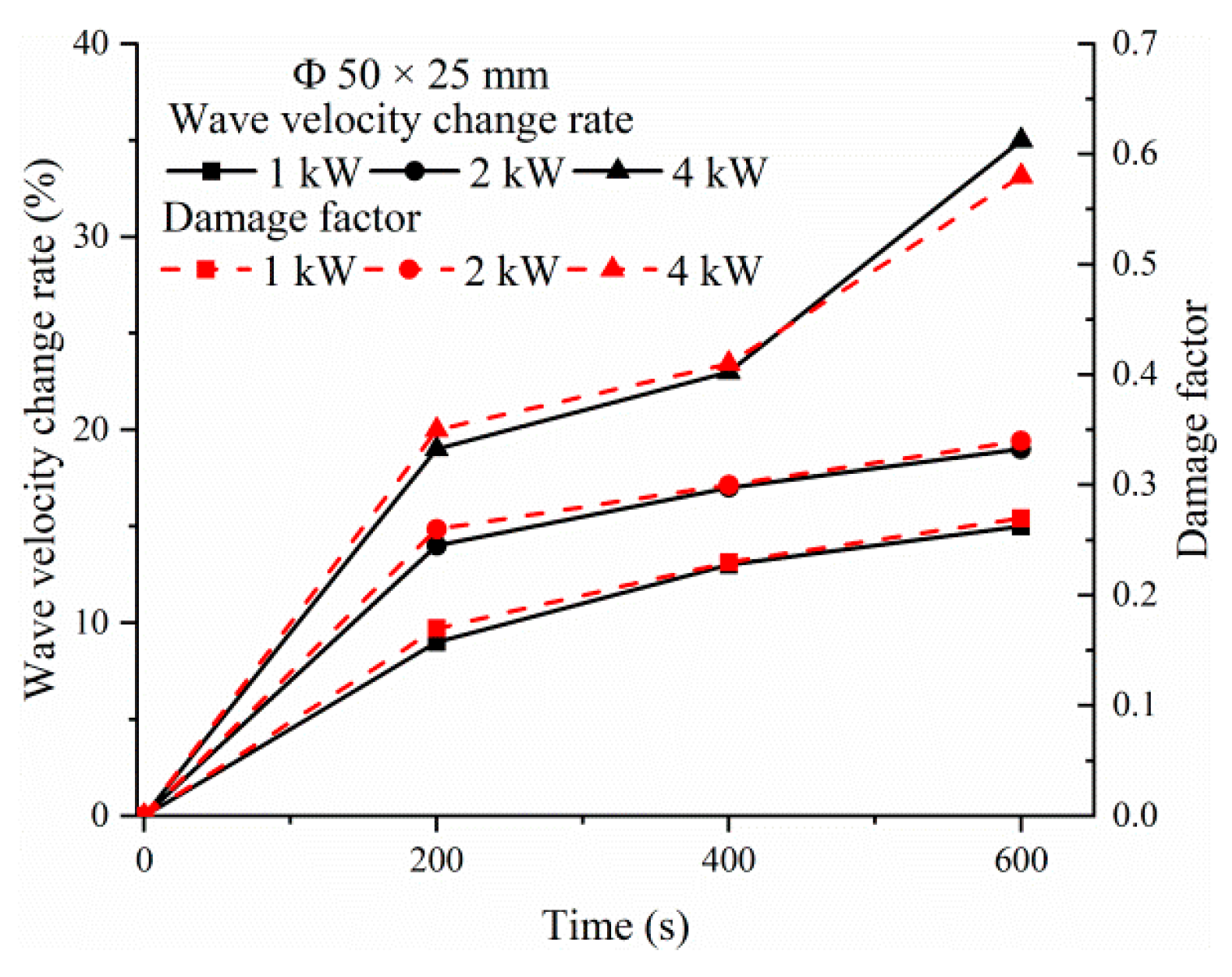




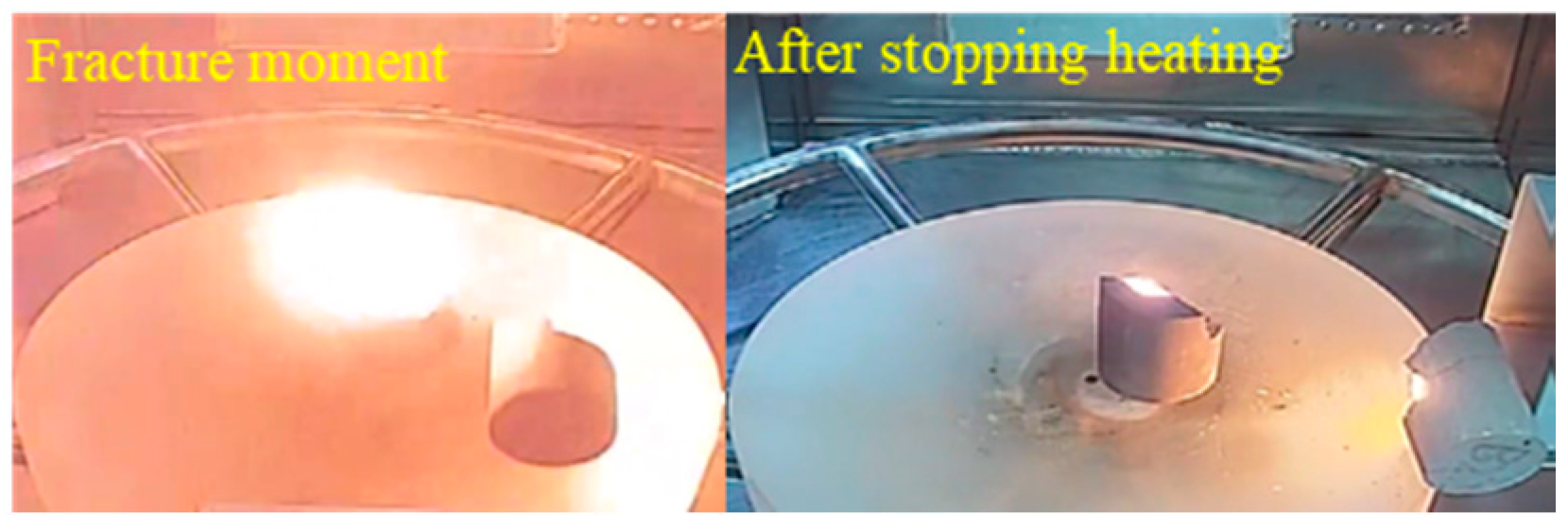

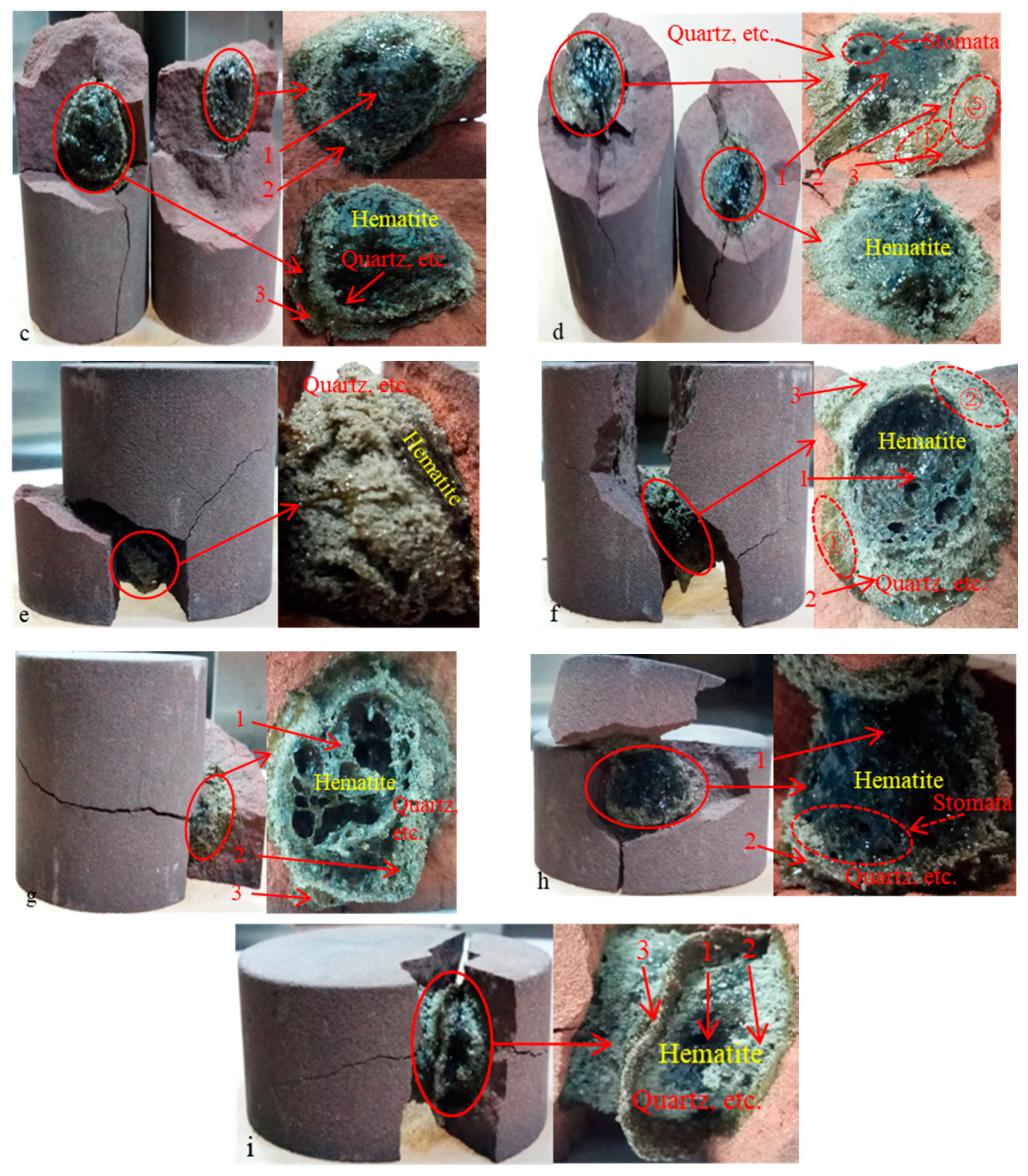
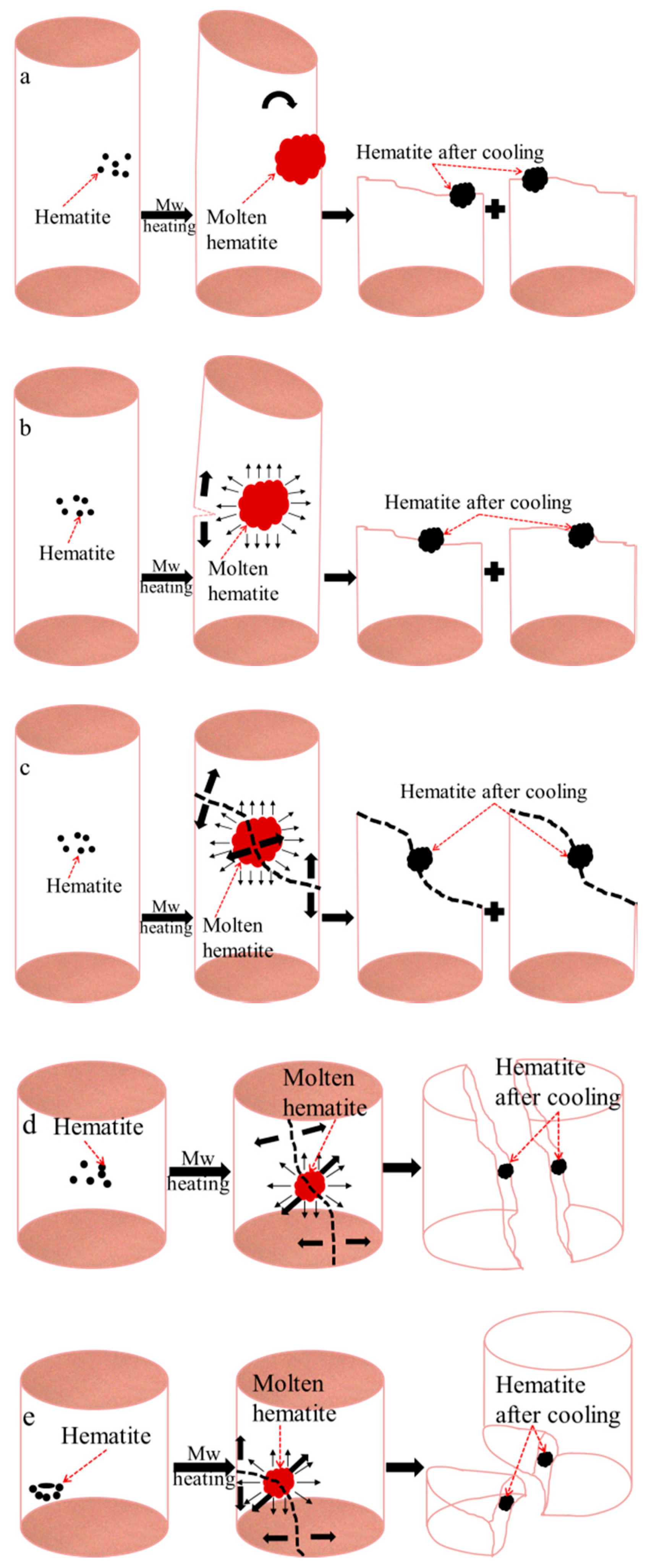

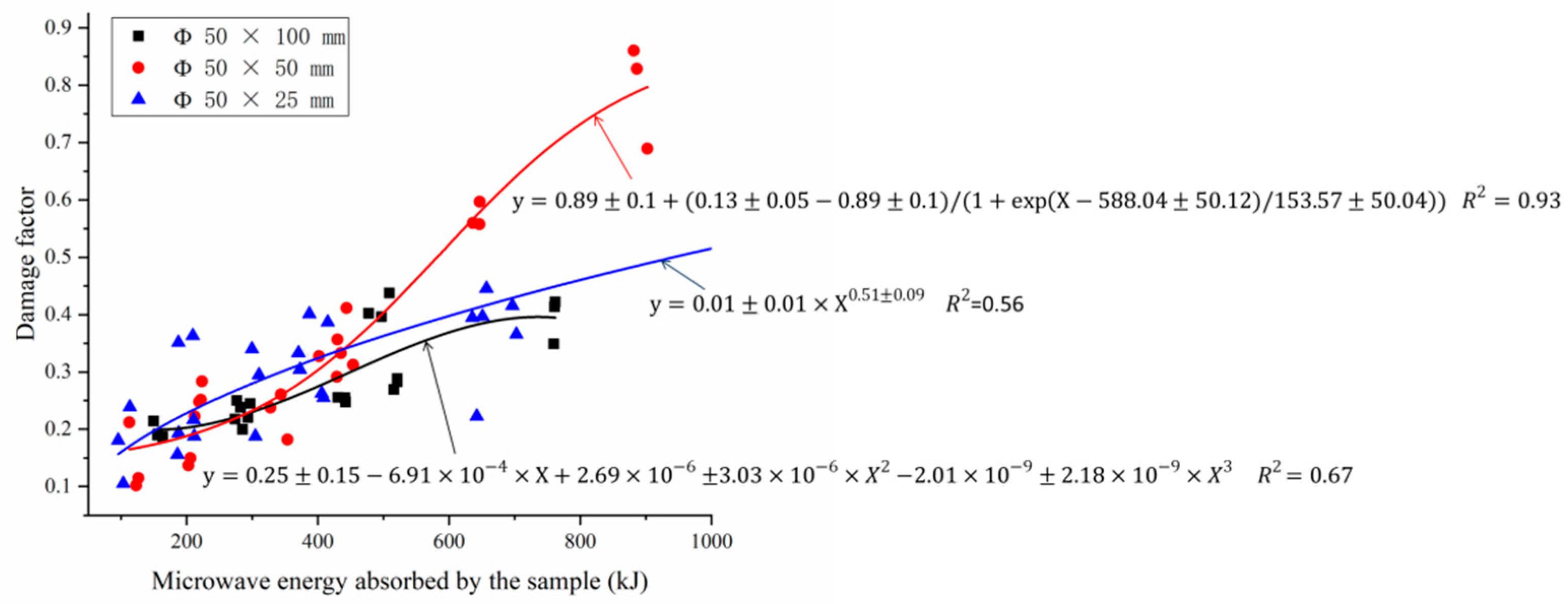
| Mineral | Quartz | Feldspar | Calcite | Hematite | Chlorite | Mica |
|---|---|---|---|---|---|---|
| Content (%) | 57.59 | 25.38 | 11.38 | 2.79 | 1.63 | 1.23 |
| Microwave absorbing properties | Very weak | Weak | Weak | Strong | Weak | Weak or medium |
© 2020 by the authors. Licensee MDPI, Basel, Switzerland. This article is an open access article distributed under the terms and conditions of the Creative Commons Attribution (CC BY) license (http://creativecommons.org/licenses/by/4.0/).
Share and Cite
Gao, F.; Shao, Y.; Zhou, K. Analysis of Microwave Thermal Stress Fracture Characteristics and Size Effect of Sandstone under Microwave Heating. Energies 2020, 13, 3614. https://doi.org/10.3390/en13143614
Gao F, Shao Y, Zhou K. Analysis of Microwave Thermal Stress Fracture Characteristics and Size Effect of Sandstone under Microwave Heating. Energies. 2020; 13(14):3614. https://doi.org/10.3390/en13143614
Chicago/Turabian StyleGao, Feng, Yan Shao, and Keping Zhou. 2020. "Analysis of Microwave Thermal Stress Fracture Characteristics and Size Effect of Sandstone under Microwave Heating" Energies 13, no. 14: 3614. https://doi.org/10.3390/en13143614
APA StyleGao, F., Shao, Y., & Zhou, K. (2020). Analysis of Microwave Thermal Stress Fracture Characteristics and Size Effect of Sandstone under Microwave Heating. Energies, 13(14), 3614. https://doi.org/10.3390/en13143614





